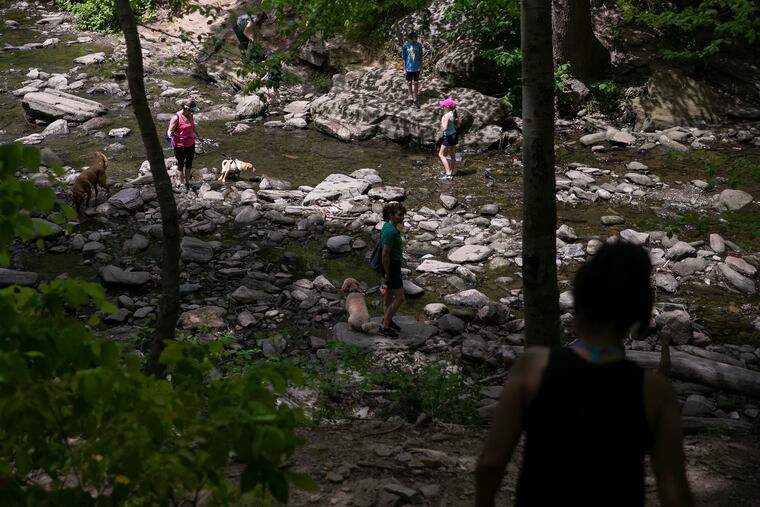Only 5% of creeks and streams have names. Here’s how they get them, and how you could name one.
More than 50,000 streams in Pennsylvania have no names. You could name one; it just might take awhile.

Hotland Run was a pipsqueak of a creek with a rather puzzling and racy name, given that it resided in a tame suburb like Marple Township in the heart of the North Temperate Zone.
Then one day a woman informed local officials that she was confident that “Hotland” was indeed a misnomer, Anthony Hamaday, a former township manager who now holds the same title in Upper Merion Township, recalled last week. She was confident the name was “Holland,” named for her 18th-century ancestors.
Thanks to a township initiative, these days it is indeed Holland Run — a name officially accepted by the U.S. Board on Geographic Names, or BGN — it is also exceptional in the very fact that it has a name, period.
» READ MORE: How does Pennsylvania grade its streams? It shocks the trout
As many as 95% of all the thousands of flowing fresh-water bodies in the country are wandering namelessly, says David S. Anderson, the U.S. Geological Survey cartographic supervisor. Granted, many of those are pipsqueaks, but even those could qualify.
The Northeast and Mid-Atlantic are veined with waterways all tied to in an immensely complicated circulatory system.
Water-quality experts say all that anonymity is a threat to the major arteries, such as the Delaware River; Schuylkill; and, ultimately the oceans, where that water is going to wind up eventually.
An anonymous stream is more likely to be a repository for litter and for unwanted runoff additives such as lawn chemicals, pet waste, and pesticides, they say.
“If a stream has a name, people can take ownership of it,” said Adam Levine, a historical consultant for the Philadelphia Water Department.
» READ MORE: Adam Levine, the sewer expert, tracks Philly’s hidden streams
Most smaller streams fall through the naming crevices, but Jennifer Runyan, a researcher with the U.S. Geological Survey, the agency that is the keeper of the Naming Board — and yes, she’s aware that it’s viewed as an “obscure” agency — says it doesn’t have to be that way. It just might take several months.
First off, just what is a ‘stream'?
The answer is more existential than one would think. BGN simply states that it is a “linear body of water flowing on the Earth’s surface.”
And here’s great news for crossword enthusiasts and headline writers: The word offers a veritable flood of synonym opportunities. Among those cited by BGN are bayou, branch, brook, creek, kill, pup, rio, river, and the aforementioned run. For various reasons some streams assume multiple identities along the way, like the Tookany Creek in Cheltenham Township that becomes the Tacony in Philadelphia and eventually turns into the Frankford.
» READ MORE: The secret scourge of climate change? More raw sewage in Philadelphia’s waterways.
As for size requirements, no stream is “too small or too insignificant to name,” Runyon says. The D River in Oregon is all of 300 feet. “A ditch without water flow except during rain” might qualify, said Anderson; Runyon pointed out that BGN approved “Dusty Creek” for a Kansas stream that gets flowing about once a decade.
How do I get one named?
Any individual or entity can apply by filling out a mail-in or online application. Opportunities abound. The Delaware River Basin Commission estimates that as many as 79,000 anonymous streams are in its territory on either side of the river, from upstate New York to Delaware Bay.
But Runyon says the board doesn’t want to open the floodgates to frivolous proposals. “If someone simply wants to honor a special person, they’re better off setting up a scholarship, sponsoring a park bench, or naming the new gym at the local high school. Geographic names are permanent markers on the landscape. ... They should be meaningful to more than the just the person who submitted the application.”
Runyon recommends including letters of support from credible sources: Local-government officials, historical societies, and the like, that attest to a stream’s worthiness for a name.
BGN, created in 1890 by President Benjamin Harrison to resolve all the geographic name issues that were popping up during the Westward expansion, includes representatives from a variety of federal agencies from Interior to Homeland Security to the Postal Service to the Defense Department.
The board has certain restrictions: No names of living people, or duplicate, too-long, commercial, or derogatory names; these days it is dealing with some existing names that might be viewed as offensive. It’s down on possessives on the ground that no one should claim ownership of a natural feature, although it did make an exception for Martha’s Vineyard in 1933.
If a case is deemed to have merit, BGN researchers will prepare a brief that will be added to the Quarterly Review List. The board will eventually take a vote.
In its application guidelines, BGN “discourages name changes unless necessary.” But it does consider them.
At its July quarterly meeting, it took up a proposal to name an anonymous tributary in Berks County “Minsi Creek,” in honor of a Lenni Lenape tribe. Last month, it voted 17-0 to change the name of “Mud Pond” in upstate Pennsylvania to “Stevens Lake.”
And awhile back, Hamaday recalled, the board acted on a change request by Marple Township officials, who had collected historical maps and passed a resolution changing “Hotland” to “Holland” Creek.
They were able to persuade BGN that somewhere along the way, a mapmaker had made a typo.